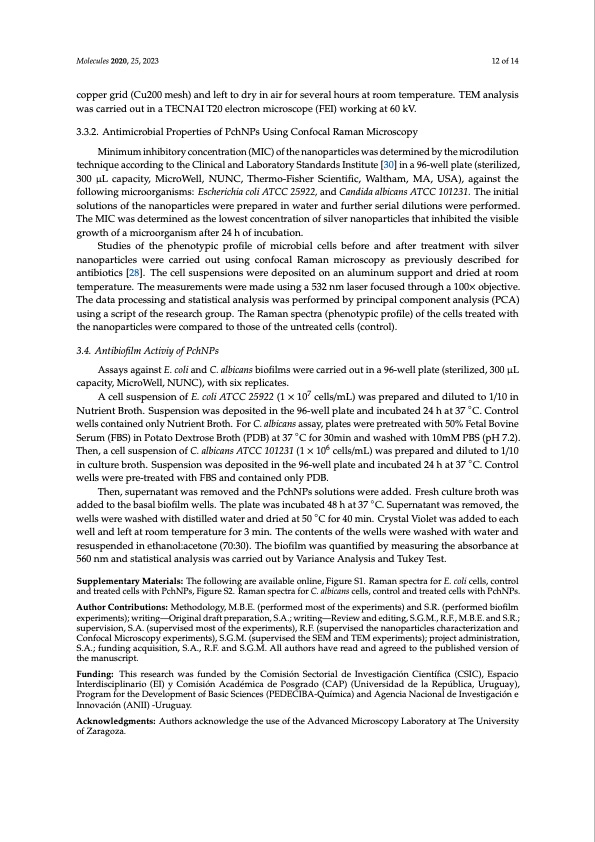
PDF Publication Title:
Text from PDF Page: 012
Molecules 2020, 25, 2023 12 of 14 copper grid (Cu200 mesh) and left to dry in air for several hours at room temperature. TEM analysis was carried out in a TECNAI T20 electron microscope (FEI) working at 60 kV. 3.3.2. Antimicrobial Properties of PchNPs Using Confocal Raman Microscopy Minimum inhibitory concentration (MIC) of the nanoparticles was determined by the microdilution technique according to the Clinical and Laboratory Standards Institute [30] in a 96-well plate (sterilized, 300 μL capacity, MicroWell, NUNC, Thermo-Fisher Scientific, Waltham, MA, USA), against the following microorganisms: Escherichia coli ATCC 25922, and Candida albicans ATCC 101231. The initial solutions of the nanoparticles were prepared in water and further serial dilutions were performed. The MIC was determined as the lowest concentration of silver nanoparticles that inhibited the visible growth of a microorganism after 24 h of incubation. Studies of the phenotypic profile of microbial cells before and after treatment with silver nanoparticles were carried out using confocal Raman microscopy as previously described for antibiotics [28]. The cell suspensions were deposited on an aluminum support and dried at room temperature. The measurements were made using a 532 nm laser focused through a 100× objective. The data processing and statistical analysis was performed by principal component analysis (PCA) using a script of the research group. The Raman spectra (phenotypic profile) of the cells treated with the nanoparticles were compared to those of the untreated cells (control). 3.4. Antibiofilm Activiy of PchNPs Assays against E. coli and C. albicans biofilms were carried out in a 96-well plate (sterilized, 300 μL capacity, MicroWell, NUNC), with six replicates. A cell suspension of E. coli ATCC 25922 (1 × 107 cells/mL) was prepared and diluted to 1/10 in Nutrient Broth. Suspension was deposited in the 96-well plate and incubated 24 h at 37 ◦C. Control wells contained only Nutrient Broth. For C. albicans assay, plates were pretreated with 50% Fetal Bovine Serum (FBS) in Potato Dextrose Broth (PDB) at 37 ◦C for 30min and washed with 10mM PBS (pH 7.2). Then, a cell suspension of C. albicans ATCC 101231 (1 × 106 cells/mL) was prepared and diluted to 1/10 in culture broth. Suspension was deposited in the 96-well plate and incubated 24 h at 37 ◦C. Control wells were pre-treated with FBS and contained only PDB. Then, supernatant was removed and the PchNPs solutions were added. Fresh culture broth was added to the basal biofilm wells. The plate was incubated 48 h at 37 ◦C. Supernatant was removed, the wells were washed with distilled water and dried at 50 ◦C for 40 min. Crystal Violet was added to each well and left at room temperature for 3 min. The contents of the wells were washed with water and resuspended in ethanol:acetone (70:30). The biofilm was quantified by measuring the absorbance at 560 nm and statistical analysis was carried out by Variance Analysis and Tukey Test. Supplementary Materials: The following are available online, Figure S1. Raman spectra for E. coli cells, control and treated cells with PchNPs, Figure S2. Raman spectra for C. albicans cells, control and treated cells with PchNPs. Author Contributions: Methodology, M.B.E. (performed most of the experiments) and S.R. (performed biofilm experiments); writing—Original draft preparation, S.A.; writing—Review and editing, S.G.M., R.F., M.B.E. and S.R.; supervision, S.A. (supervised most of the experiments), R.F. (supervised the nanoparticles characterization and Confocal Microscopy experiments), S.G.M. (supervised the SEM and TEM experiments); project administration, S.A.; funding acquisition, S.A., R.F. and S.G.M. All authors have read and agreed to the published version of the manuscript. Funding: This research was funded by the Comisión Sectorial de Investigación Científica (CSIC), Espacio Interdisciplinario (EI) y Comisión Académica de Posgrado (CAP) (Universidad de la República, Uruguay), Program for the Development of Basic Sciences (PEDECIBA-Química) and Agencia Nacional de Investigación e Innovación (ANII) -Uruguay. Acknowledgments: Authors acknowledge the use of the Advanced Microscopy Laboratory at The University of Zaragoza.PDF Image | Biofilm Eradication Using Biogenic Silver Nanoparticles

PDF Search Title:
Biofilm Eradication Using Biogenic Silver NanoparticlesOriginal File Name Searched:
molecules-25-02023-v2.pdfDIY PDF Search: Google It | Yahoo | Bing
Turbine and System Plans CAD CAM: Special for this month, any plans are $10,000 for complete Cad/Cam blueprints. License is for one build. Try before you buy a production license. More Info
Waste Heat Power Technology: Organic Rankine Cycle uses waste heat to make electricity, shaft horsepower and cooling. More Info
All Turbine and System Products: Infinity Turbine ORD systems, turbine generator sets, build plans and more to use your waste heat from 30C to 100C. More Info
CO2 Phase Change Demonstrator: CO2 goes supercritical at 30 C. This is a experimental platform which you can use to demonstrate phase change with low heat. Includes integration area for small CO2 turbine, static generator, and more. This can also be used for a GTL Gas to Liquids experimental platform. More Info
Introducing the Infinity Turbine Products Infinity Turbine develops and builds systems for making power from waste heat. It also is working on innovative strategies for storing, making, and deploying energy. More Info
Need Strategy? Use our Consulting and analyst services Infinity Turbine LLC is pleased to announce its consulting and analyst services. We have worked in the renewable energy industry as a researcher, developing sales and markets, along with may inventions and innovations. More Info
Made in USA with Global Energy Millennial Web Engine These pages were made with the Global Energy Web PDF Engine using Filemaker (Claris) software.
Infinity Turbine Developing Spinning Disc Reactor SDR or Spinning Disc Reactors reduce processing time for liquid production of Silver Nanoparticles.
| CONTACT TEL: 608-238-6001 Email: greg@infinityturbine.com | RSS | AMP |